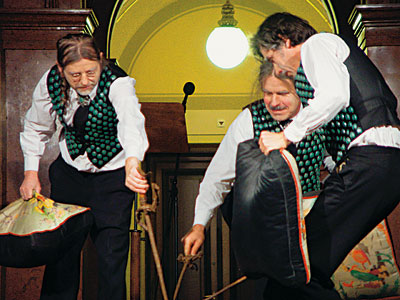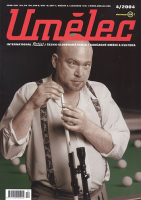| Umělec 2004/4 >> Cold, stabbing, cuting | Просмотр всех номеров | ||||||||||||
|
|||||||||||||
Cold, stabbing, cutingUmělec 2004/401.04.2004 Lenka Vítková | review | en cs |
|||||||||||||
|
The members of the secret fellowship BKS (Bude konec světa - The End of World is Coming) presented their weapons on the 10th of November at the occasion of the exhibition Skála at the Rudolfinum. The exhibition of weaponry is a well-tried demonstration of power still not limited to any particular opponent. In this case, BKS also presented the enemy. The action was a double propaganda move.
“BKS has its arsenal of mostly cold, stabbing and cutting weapons. At the third BKS congress, held in London, all these weapons were used for what is known as the ikebana of weaponry. That is a Central European way of arranging weapons on walls symmetrically. All the weapons were transported to London and everything ran smoothly, no one tried to cause problems. Part of this arsenal of ours is to be presented at the Rudolfinum, in precisely the same way that people present cosmetics or other goods,“1 said František Skála. And that is as it happened. The weapons were presented on a runway stage set in the main lobby of the gallery, accompanied by a presenter who announced the name and catalog number of each weapon, as BKS members demonstrated the function. Many of the names of the weapons are descriptive (Offensive Tampon, Defensive Bats), they sometimes confuse (A Heavy Rifle Brakeman’s Cudweed), or they allude to something (Hatchetstick, Cubist, Flail, A Revolutionary Reaper), and some of them gratify (Penknife Salamander, the Sharpest Weapon in the World). Supporting the ongoing procurement of the groups armaments, the weapons presented at the Rudolfinum had not been seen in previous materials about BKS.2 With physical performances, BKS commented on the present day popularity of golf and exotic martial arts. Whereas oriental combat is an art of trained men, here the battle is with artificial and natural materials. The vegetable and industrial products received the worst treatment. František Skála works mainly with natural materials, but he also employs metal and some synthetic materials, often well-worn, decaying, or otherwise seeming to be returning to nature. The materials themselves, on a balanced level of “artificiality” in which they are on the margin of usability or edible, are the theme of Skála’s works. Shabbiness and decline are dynamic processes that enhance some aspects of material. With their structure bared—they crumble, corrode, molder, chap, get smeared, and rust—we can more clearly perceive their ephemeral and unique qualities, particularly as they interact with their surroundings. A fresh cauliflower is never anything more than a cauliflower. Because of their simple-minded perfection of trivial vegetables, such as cauliflower, beet or cabbage were appropriately dispatched, as were industrial products, parts of computers or an orange cardboard suitcase. It is hard to imagine how the weapons of BKS would assault a section of contorted driftwood. BKS doesn’t deny its predecessors. The Hussites made use of anything they found at home, using them as killing tools, and they succeeded in winning a lot with them. BKS brings to battle chopping boards, paddles and mattresses. But it is clear that the role of BKS’ weapons is not so much to defeat the enemy as it is to represent and decorate; they are to be hung on the walls of secret assembly points, to catch dust and to rot away. Although BKS is not František Skála alone, the design of the weaponry corresponds closely with Skála’s aesthetics and the show was presented as a side-show to his exhibition. František Skála said a few times that he feels the need to somehow vent innate destructive and aggressive impulses. He recalled how he and a schoolmate laboriously built a wooden city just to watch a fire destroy it. The beginning of the show presented the weapons as obscure curiosities; it seemed to be a sincere performance to represent these objects, and the role of the BKS members was simply to bring them closer to the victims’ and viewers’ eyes. But the members of BKS got increasingly carried away over the course of the soiree... The daily newspaper Dalibor wrote on February 14, 1885 that the arts building (Dům umělců), which is now called the Rudolphinum, had then become “a new stronghold for efforts hostile to the Czech nation...a ram against the Czech culture“3 Dalibor couldn’t have imagined that barely 120 years later, that hated institution would experience what amounted to a third defenestration, and that the swinging ball of a mace would tear loose from its staff and splash into the central fountain. Let us imagine ourselves in that marble-paneled central chamber of the Rudolfinum. The upstairs gallery is just closing for the evening and the day’s last visitors straggle down the grand staircase accompanied by the dulcet tones of Shostakovich. On the runway stage in the middle of the darkened hall stands a white-haired man, posing under the illuminated central chandelier. Among the viewers two dark figures inconspicuously wander about wearing black overcoats and hairy Cossack hats, one of whom holds a long spike on whose end is stuck a stuffed squirrel, they meet the uniformed representative and exchange some material they have in their pouches. The moderator then steps up to the podium and announces: A show of weapons cutting, stabbing and opulent, mostly cold. Weapons opulent. A propagation flail, usually carried at the head of the procession. Material: plum, spruce, steel, plastic. Cubist. Salon mace for a personal representation. Bronze... Notes: 1. Czech Radio Radiožurnál, Dva na jednoho, October 18, 2004, 12.30 pm 2. B.K.S. DVACET LET TAJNÉ ORGANIZACE, Výtvarné umění Magazine 3/94 3. Vybíral Jindřich: Emporium krásných umění. In: Česká architektura na prahu moderní doby. Prague: Argo/VŠUP 2002
01.04.2004
Рекомендуемые статьи
|
|||||||||||||













Комментарии
Статья не была прокомментированаДобавить новый комментарий